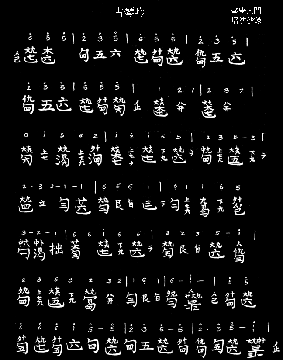|
(Song of Gu Qin) 古琴吟(相思曲) Gu Qin Yin 古琴吟 (Song of Gu Qin) also called Xiang Si Qu 相思曲 (Melody of Longing). This piece has a lyric. The earliest version of Gu Qin Yin, (Xiang Si Qu), was composed by Yang Biao-zheng 楊表正 from the Ming dynasty (1585). His “Xiang Si Qu” has the same lyrics as “Gu Qin Yin” from the Qinxue Rumen [琴學入門] by Zhang-he 張鶴 from the Qin dynasty (1864), as preserved in the Guqin Quji [古琴曲集] -- published by Bejing Renmin Yinyue Publisher, 1962. However, these two pieces have different melodies. In order to distinguish them, I call the piece “Gu Qin Yin” which I play from Guqin Quji and the piece “Xiang Si Qu” which I play from Yang's version. They both are clean and profound. The translation of the lyrics: Songs, So many songs, Such heartless, Truly heartless. Disappoint me, Disappoint me, Until now. Remembering the old time when we were singing softly and pouring the wine gently. Each of my sounds worth thousands in gold. Now abandon me at the shady side of this old wall. Autumn winds blow the weeds. White clouds cover deeply. Flowing water, high mountains, where to find my friend. Bitter sorrow, cheerless cold, tell me how to bear it. The lyrics come from a ghost story. Song dynasty poet Su Dongpo (1037-1101) once traveled to Qiong-zho's Hong-fo temple with a skilled woman who could sing and play guqin. Later she died of an illness and was buried with her qin behind the temple, beside a wall. Years later, when there was a provincial governor staying at the temple, he often heard a woman's crying and singing in the night. He questioned the monks and had them dig out the ground where he heard the sound and found a coffin. When they opened it they saw the women with a qin and a piece of music lyrics, called Xiang Si Qu, which was same as the song he had heard during the night. 古琴吟又稱相思曲 是有歌詞之琴曲 現存最早的相思曲是存於明楊表正的【新刊正文對音捷要琴譜】(1585) 與現今流傳的古琴吟 雖解題與歌詞都同 然曲調旋律卻不盡相同 因而在此將兩曲分別以'古琴吟'和'相思曲'之稱以示區別 吾所彈之古琴吟是跟據清張鶴的【琴學入門】(1864) [收錄於北京人民音樂出版社出版的【古琴曲集】(1962)] 所彈 而相思曲則是打譜於【新刊正文對音捷要琴譜】 兩曲均為簡約柔麗之小曲 歌詞: 音音音 恁負心 真負心 辜負俺 辜負俺 到如今 記得當初低低唱 淺淺斟 一曲值千金 如今撇我在古墻陰 秋風衰草白雲深 流水高山何處尋 悲悲切切 冷冷清清 叫人怎禁 解題:(據新刊正文對音捷要琴譜) 昔蘇子攜妓抱琴 常遊瓊州紅拂寺 而後妓忽染疾亡 即以琴殉 葬之寺後粉牆西 後州守夜宿茲寺 忽聞女子哽咽悲歌 更次不去 曉 乃究僧隱淫之罪 眾莫知其由 老僧稟曰 聞前朝蘇學士攜葬一妓於寺後 想此妓之魂歟 遂命發棺 見女抱琴 誌詞一闋 名曰相思曲 與夜歌同 寺僧方釋 其曲雖小寓意亦妙而微也 Composed by Yang Biao-zheng. performed by Peiyou Chang  Click picture to see the Xiang Si Qu notation. Gu Qin Yin from the Qinxue Rumen [琴學入門] performed by Peiyou Chang  Click picture to see the Gu Qin Yin notation and video of Peiyou's playing. Gŭ Qín Yín (Song of Gŭ Qín) Finger Technique Explanation
This finger technique explanation is using some of the notes from Gu
Qin Yin (Qinxue Rumen). By studying this notation, one should be able to figure out
the rest of the notes of this piece. 
Fàn-Qĭ:
start using Fàn Yīn
(Harmonics)(Lightly touch).
Dà-zhĭ
Jiŭ Huī,
Tiăo Qī
Xián:
Mŭo Tiăo
Liò Xián:
Gōu Sì
Xián:
Míng-zhĭ
Shí Huī,
Gōu Sì
Xián:
Shí-zhĭ
Jiŭ Huī,
Gōu Sì
Xián: 
Dà-zhĭ
Qī Liò,
Mŭo Tiăo
Qī Xián: 
Fēn Kāi
:When the left hand presses down a string and after the right hand
has played the string, the left hand glides up to the next Hui
position to the right; and then while the right hand plays the string
again, the left hand glides back to where it started. Usually this
symbol needs to be read together with its previous note.
Shàng Qī:
Move up to the 7th Hui.
Xià Jiŭ:
Move down to the 9th Hui.
Yín: A vibrato
movement.
Zhuàng: to strike
against. 
Săn Tiăo
Liò Xián: 
Zhōng-zhĭ
Jiŭ Huī,
Gōu Sì
Xián:
Tuì: Move backward.
Fù: Move forward.
Jù Tì
Èr Xián: 
Míng-zhĭ
Shí Huī,
Dà-zhĭ
Qiā Qĭ: 
Zhōng-zhĭ
Huī-wài,
Zhù Tì
Yī Xián: 
Tuē Chū: 
Dà-zhĭ
Jiŭ Huī,
Gōu Tì
Sì Xián: 
Dà-zhĭ
Jiŭ Huī,
Zhōng-zhĭ
Shí Huī,
Zuō Yī
Sān Xián: | ||||